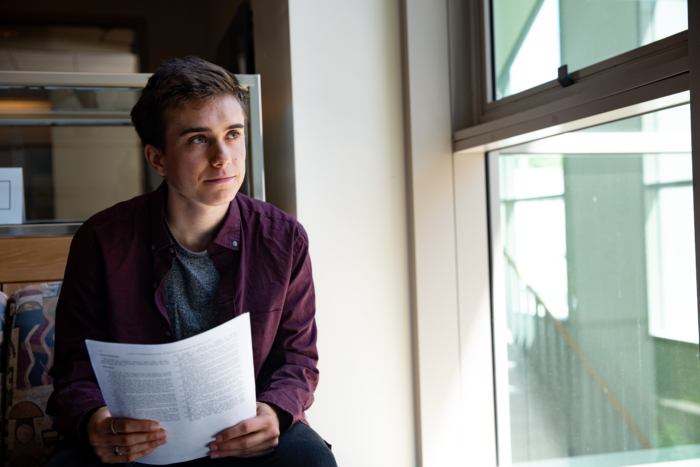By Rachel Morrison
Scientists have several ways of peering inside the human body. The bluntest tool is the X-ray, followed by MRI. These technologies are highly effective, but they are limited in their application. In order to see the more minute aspects of an organism, like individual cells, more sophisticated tools are needed.

With the advent of fluorescent microscopy, scientists can use fluorescent dyes and special microscopes to see the inside of cells. However, these methods require that the cells be removed from the organism, which means researchers lose the important context of how they behave within a living entity.
But what if cells could be programmed to generate their own light so that they glow within a living organism? Researchers in the W.M. Keck Science Department’s Leconte Lab are answering this question using a mixture of chemistry, protein engineering, and molecular biology.
“For 20 years now, scientists have been utilizing bioluminescence as a tool for studying how cells function. We are trying to make new versions of these proteins that will allow not just studying individual cells, but the interaction of many types of cells in a complex environment,” explains Associate Professor of Chemistry Aaron Leconte. Supported by the Research Corporation for Science Advancement Cottrell Scholars program, Leconte’s project aims to harness and modify the illuminating power of fireflies to develop more advanced techniques for imaging biological systems.
As a summer research assistant in the Leconte Lab, Edison Reid-McLaughlin ’21 has been gaining invaluable experience in all aspects of this interdisciplinary project.
The first thing Reid-McLaughlin does when he arrives at work each morning is retrieve bacteria from an incubator and feed them their breakfast of sugar, so they grow “robust and expressive”—all before breaking them open to access the enzymes painstakingly encoded into their DNA.
The gene for the enzyme, called Firefly luciferase (F-Luc), is inserted into mice with tumors so that the cancerous cells generate their own light. Using sophisticated cameras, scientists may then track the luminescent cells as they travel within the organism.
“Bioluminescent imaging isn’t really used in humans yet,” explains Reid-McLaughlin. “But by learning about how cells behave in mouse models of human diseases, we can learn a lot that could be applied to humans later.”
For example, by seeing how cancer metastasizes (that is, how the cells break away from the primary tumor and travel to new areas of the body) in a mouse model, scientists can form a more nuanced understanding of how cancer cells behave in general, which gives them a good starting place for developing drugs or therapies that could be used in human diagnostics and treatment. “This field of research has immediate implications for understanding diseases and is an essential step in developing meaningful treatments,” says Leconte.
Reid-McLaughlin got involved with the Leconte Lab after taking an interdisciplinary introductory chemistry and introductory biology course. The traditional laboratory curriculum was replaced with first-hand research experience, during which Reid-McLaughlin learned sophisticated research techniques and gained an appreciation for open-ended, interdisciplinary lab work. “The first thing I learned was how to handle DNA to figure out how much it weighs,” he recalls, adding that “Scripps’ small size and the personable nature of the professors really cultivates students as future scientists.”
In addition to nurturing the F-luc enzymes in the bacteria, Reid-McLaughlin assists with computational processing and data analysis. This aspect of the project is indispensable, as Leconte’s research is at the crux of science and big data.
“One of the challenges in bioluminescent research is that scientists want the enzyme tailored for different imaging applications, but not much is known about Firefly luciferase,” explains Leconte. “To learn about it, scientists have traditionally changed its amino acids one at a time, creating mutations and carefully measuring the effects, but this is a really slow and limited approach. Edison’s project for this summer is to initiate new approaches that can characterize hundreds to thousands of amino acid changes in a single experiment, rapidly speeding up discovery. I was confident that Edison had the intelligence, ambition, and perseverance to take on a big, challenging project like this. He has already pushed the science forward extremely quickly even in a short amount of time and he’ll be leading this project for years to come.”
But for Reid-McLaughlin, scientific research is only part of his future plans. He, too, is guided by an inner light: the desire to help others through education as others have helped him.
“I want to be a scientist, but I also want to be a professor. Had I not met Professor Leconte and my other instructors at Scripps, I wouldn’t have even thought about that,” says Reid-McLaughlin, who is already getting teaching experience by working as a teaching assistant and tutor for a first-year chemistry course and who is an active member of the Queer Resource Center’s Alliance Club. “Being at Scripps motivates me to want to do for others what they have done for me, teaching and encouraging me to pursue my passion.”

